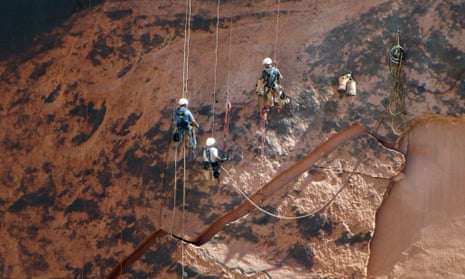A massive piece of rock is at risk of crashing down from a canyon wall to the base of an Arizona dam, prompting the government to send in a crew of rappellers to keep the slab in place.
The 500,000-pound slab – weighing more than many jumbo jets – began to break away from the canyon wall last week in what the US Bureau of Reclamation attributes to erosion that is typical for that type of rock. The area below the slab includes a passageway to a boat ramp, a machine shop and water and power facilities for the Glen Canyon Dam in Page, near the Arizona-Utah border.
The Bureau of Reclamation has cut off access to the boat ramp, putting some rafting trips on hold until the rock can be secured.
A three-person crew has been scaling the towering walls to drill bolts that range from 6ft to 8ft into the sandstone. Six bolts were placed in the canyon wall a week ago before a small chunk broke loose and crashed to the ground, hitting a building and leaving a pile of rubble, Bureau of Reclamation spokesman Chris Watt said.
“It’s just plain luck that it didn’t cause more damage because we don’t know how big of chunks are going to fall,” he said. “If more of it falls, that’s a real concern.”
The slab measures 30ft at its widest point and is 50ft tall. Its thickness ranges from 6in to 4ft, he said.
The plan is to attach bolts in the area above the crack to make sure it’s safe enough for crews to then work on the slab that is in jeopardy of falling. Temperatures can top 110 degrees on the face of the wall, limiting the hours the crew can work, Watt said. The work isn’t expected to be complete until the first week of October.
The slab is about 150ft away from the edge of the dam, which is not in danger of being hit by the rock. Watt also said the location is at constant risk of falling rock, and engineers have constructed protections at the site such as stronger buildings and an area designed to catch falling rock.

For now, a rafting company that takes tourists from the base of the dam down the Colorado River to Lees Ferry has cut down on the number of daily trips. Colorado River Discovery general manager Korey Seyler said the company is now launching at Lees Ferry, about 15 miles downstream, and traveling up the river until it gets the OK to resume normal operations.
“It certainly has had a major impact on us, as all of our trips depart from the base of the dam,” he said. “We’ve ceased having the ability to access the area.”
Rock falls aren’t uncommon at Glen Canyon. The layer of rock known as Navajo sandstone is common in the south-west, particularly in Utah, and is prone to cracks due to erosion. This crack is the largest one in years, and workers at the dam have been watching it closely, Watt said.
Frank Talbott, a former river guide who lives just outside Page, said rocks have fallen into the river and taken out part of a catwalk that goes to the lower part of the dam.
“They just happen, and it doesn’t hurt anything, unless it’s right at a special place at the dam,” he said.

Comments (…)
Sign in or create your Guardian account to join the discussion